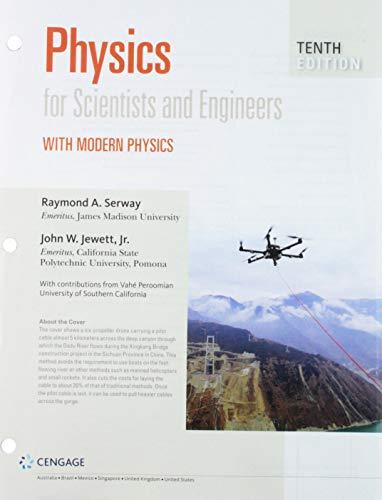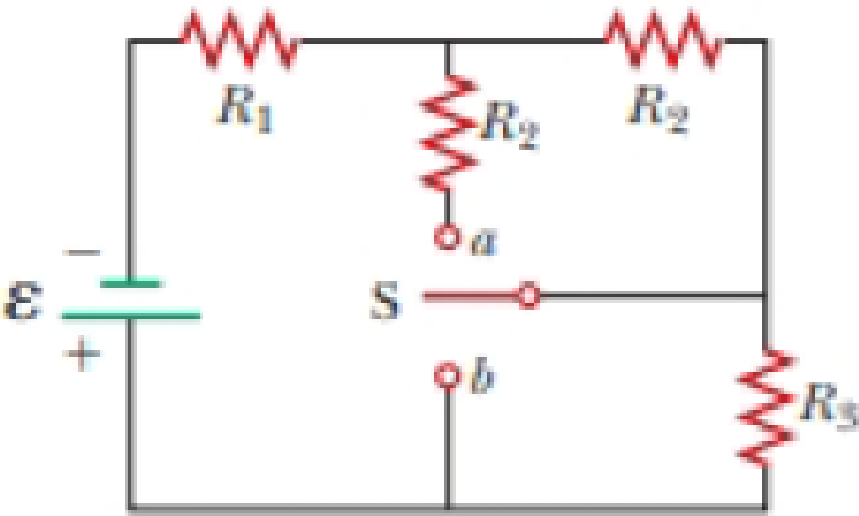
A battery with emf ε and no internal resistance supplies current to the circuit shown in Figure P27.9. When the double-throw switch S is open as shown in the figure, the current in the battery is I0. When the switch is closed in position a, the current in the battery is Ia. When the switch is closed in position b, the current in the battery is Ib. Find the resistances (a) R1, (b) R2, and (c) R3.
Figure P27.9 Problems 9 and 10.

(a)
The expression of the resistance
Answer to Problem 10P
The expression of the resistance
Explanation of Solution
Given information: Emf across the battery is
When the switch S is open, then the three resistors
Formula to calculate the equivalent resistance across the circuit, when the switch S is open.
Here,
As the total emf across the battery is equal to the voltage across the battery.
Here,
Substitute
Formula to calculate the equivalent resistance across the circuit, when the switch S is open.
Here,
Substitute
When the switch is closed in position
From equation (2), formula to calculate the equivalent resistance across the circuit, when the switch is closed in position
Here,
Formula to calculate the resistance when the resistors are connected in parallel.
From equation (3), formula to calculate the equivalent resistance across the circuit, when the switch is closed in position
Substitute
Substitute
When the switch is closed in position
From equation (2), formula to calculate the equivalent resistance across the circuit, when the switch is closed in position
Here,
From equation (3), formula to calculate the equivalent resistance across the circuit, when the switch is closed in position
Substitute
Subtract equation (11) from (4) to find
Thus, the expression of the resistance
Subtract equation (11) from (8) to find
Substitute
Thus, the expression of the resistance
Substitute
Thus, the expression of the resistance
Conclusion:
Therefore, the expression of the resistance
(b)
The expression of the resistance
Answer to Problem 10P
The expression of the resistance
Explanation of Solution
Given information: Emf across the battery is
From part (a) equation (17), the expression for the resistance
Thus, the expression of the resistance
Conclusion:
Therefore, the expression of the resistance
(c)
The expression of the resistance
Answer to Problem 10P
The expression of the resistance
Explanation of Solution
Given information: Emf across the battery is
From part (a) equation (15), the expression for the resistance
Thus, the expression of the resistance
Conclusion:
Therefore, the expression of the resistance
Want to see more full solutions like this?
Chapter 27 Solutions
Bundle: Physics For Scientists And Engineers With Modern Physics, Loose-leaf Version, 10th + Webassign Printed Access Card For Serway/jewett's Physics For Scientists And Engineers, 10th, Single-term
Additional Science Textbook Solutions
Essentials of Human Anatomy & Physiology (12th Edition)
Human Physiology: An Integrated Approach (8th Edition)
Anatomy & Physiology (6th Edition)
Fundamentals Of Thermodynamics
Cosmic Perspective Fundamentals
- Please help me with this physics problemarrow_forwardIn a scene from The Avengers (the first one) Black Widow is boosted directly upwards by Captain America, where she then grabs on to a Chitauri speeder that is 15.0 feet above her and hangs on. She is in the air for 1.04 s. A) With what initial velocity was Black Widow launched? 1 m = 3.28 ft B) What was Black Widow’s velocity just before she grabbed the speeder? Assume upwards is the positive direction.arrow_forwardIn Dark Souls 3 you can kill the Ancient Wyvern by dropping on its head from above it. Let’s say you jump off the ledge with an initial velocity of 3.86 mph and spend 1.72 s in the air before hitting the wyvern’s head. Assume the gravity is the same as that of Earth and upwards is the positive direction. Also, 1 mile = 1609 m. A) How high up is the the ledge you jumped from as measured from the wyvern’s head? B) What is your velocity when you hit the wyvern?arrow_forward
- No chatgpt pls will upvote Alreadyarrow_forwardTwo objects get pushed by the same magnitude of force. One object is 10x more massive. How does the rate of change of momentum for the more massive object compare with the less massive one? Please be able to explain why in terms of a quantitative statement found in the chapter.arrow_forwardA box is dropped on a level conveyor belt that is moving at 4.5 m/s in the +x direction in a shipping facility. The box/belt friction coefficient is 0.15. For what duration will the box slide on the belt? In which direction does the friction force act on the box? How far will the box have moved horizontally by the time it stops sliding along the belt?arrow_forward
 Physics for Scientists and Engineers with Modern ...PhysicsISBN:9781337553292Author:Raymond A. Serway, John W. JewettPublisher:Cengage Learning
Physics for Scientists and Engineers with Modern ...PhysicsISBN:9781337553292Author:Raymond A. Serway, John W. JewettPublisher:Cengage Learning Physics for Scientists and Engineers: Foundations...PhysicsISBN:9781133939146Author:Katz, Debora M.Publisher:Cengage Learning
Physics for Scientists and Engineers: Foundations...PhysicsISBN:9781133939146Author:Katz, Debora M.Publisher:Cengage Learning Physics for Scientists and EngineersPhysicsISBN:9781337553278Author:Raymond A. Serway, John W. JewettPublisher:Cengage Learning
Physics for Scientists and EngineersPhysicsISBN:9781337553278Author:Raymond A. Serway, John W. JewettPublisher:Cengage Learning Physics for Scientists and Engineers, Technology ...PhysicsISBN:9781305116399Author:Raymond A. Serway, John W. JewettPublisher:Cengage Learning
Physics for Scientists and Engineers, Technology ...PhysicsISBN:9781305116399Author:Raymond A. Serway, John W. JewettPublisher:Cengage Learning Principles of Physics: A Calculus-Based TextPhysicsISBN:9781133104261Author:Raymond A. Serway, John W. JewettPublisher:Cengage Learning
Principles of Physics: A Calculus-Based TextPhysicsISBN:9781133104261Author:Raymond A. Serway, John W. JewettPublisher:Cengage Learning College PhysicsPhysicsISBN:9781305952300Author:Raymond A. Serway, Chris VuillePublisher:Cengage Learning
College PhysicsPhysicsISBN:9781305952300Author:Raymond A. Serway, Chris VuillePublisher:Cengage Learning





